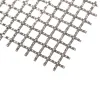Crimped woven wire screens are widely used in various industries for a range of applications due to their versatility, durability, and effectiveness. These screens consist of wires that are woven together in a crimped pattern, creating a sturdy mesh structure with uniform openings. The specific uses of crimped woven wire screens vary depending on the industry and application, but they are commonly employed for the following purposes:
Screening and Sizing: One of the primary uses of crimped woven wire screens is for screening and sizing materials. These screens are commonly installed in vibrating screens and trommel screens to separate particles of different sizes. They are used in industries such as mining, quarrying, aggregate production, construction, and recycling to classify materials into different size fractions. Crimped wire screens with various opening sizes and wire diameters can be selected to achieve the desired particle size distribution.
Aggregate and Mineral Processing: In the mining and mineral processing industries, crimped woven wire screens are essential for separating and classifying minerals, aggregates, and other bulk materials. They are used in vibrating screens, scalping screens, and quarry screen mesh to efficiently process raw materials and recover valuable minerals. Crimped wire screens can withstand the harsh operating conditions encountered in mining and mineral processing operations, including high vibration, abrasion, and impact.
Industrial Filtration: Crimped woven wire screens are widely used for industrial filtration applications due to their ability to retain particles while allowing liquids or gases to pass through. They are used in filtration systems for water treatment, oil and gas processing, chemical processing, food and beverage production, pharmaceutical manufacturing, and other industries. These screens can be manufactured with different mesh sizes and wire diameters to achieve the desired filtration efficiency and particle retention.

Architectural and Decorative Applications: Crimped woven wire screens are also used for architectural and decorative purposes due to their aesthetic appeal and design flexibility. They are commonly used as decorative facades, cladding panels, room dividers, railing infill panels, and sunscreens in commercial buildings, residential properties, public spaces, and landscaping projects. Crimped wire screens can be fabricated from various materials, including stainless steel, aluminum, brass, and copper, to achieve different visual effects and design styles.
Agricultural and Horticultural Applications: In the agricultural and horticultural industries, crimped woven wire screens are used for various purposes, including animal enclosures, crop protection, soil sieving, and drainage applications. These screens are used in agricultural machinery such as seed cleaners, grain separators, and soil sifters to remove impurities and separate materials based on size. They are also used as fencing, cages, and barriers to protect crops, livestock, and property from pests and predators.
Security and Safety: Crimped woven wire screens are often used for security and safety purposes in commercial, industrial, and residential settings. They are used as window screens, door screens, security screens, and fencing panels to provide protection against intruders, insects, and wildlife. These screens can be fabricated with heavy-duty materials and reinforced designs to enhance security and withstand forced entry attempts.
Noise and Vibration Control: Crimped woven wire screens can also be used for noise and vibration control applications in industrial facilities, transportation infrastructure, and building construction projects. They are used as sound barriers, acoustic panels, and vibration damping screens to reduce noise pollution and vibration transmission. These woven screens can be designed with specific mesh configurations and mounting methods to optimize their acoustic and vibration damping properties.
In conclusion, crimped woven wire screens are versatile and widely used in various industries for screening, sizing, filtration, architectural, agricultural, security, and noise control applications. Their durability, effectiveness, and design flexibility make them suitable for a wide range of industrial and commercial applications, where they play a crucial role in improving efficiency, productivity, safety, and quality.



Comments
Please Join Us to post.
0